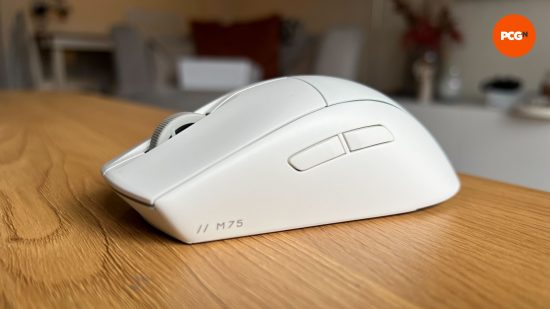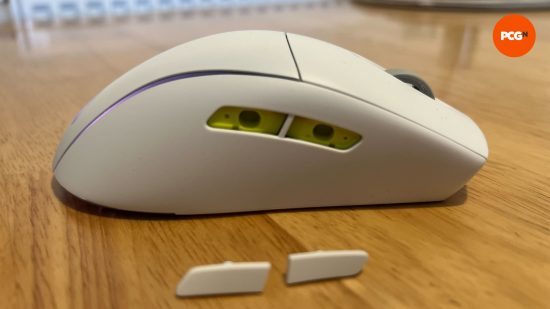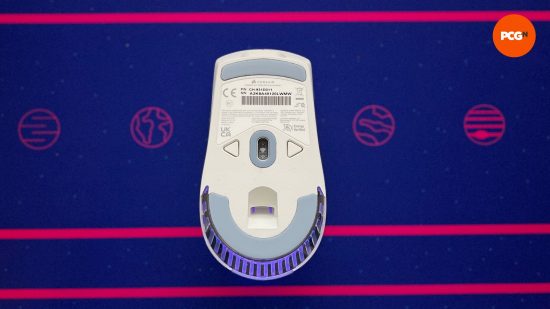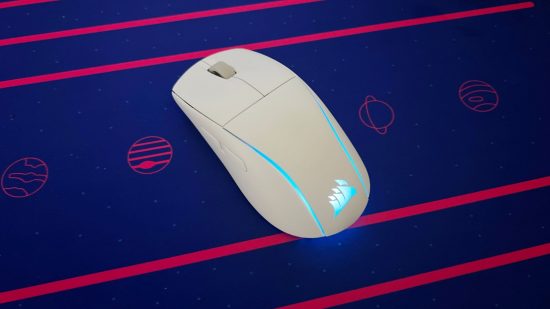Our Verdict
The Corsair M75 Wireless is a fantastic gaming mouse, but it's priced too high for the features on offer when compared to the competition - it's ultimately a reskin of the M75 Air, but heavier. Its big selling points are the long-lasting battery, great grip comfort, ambidextrous shape, and swappable side buttons. However, a maximum 2,000Hz polling rate leaves it exposed against competitors who have already implemented 8KHz, and the 89g weight sometimes feels a little sluggish, but will be a draw to those who favor a heavier mouse.
- Incredible battery life
- Super comfortable for claw and palm grips
- Well-implemented ambidextrous design
- RGB doesn’t kill the battery
- Priced a little high
- 89g isn't lightweight
Corsair is adding to its M75 gaming mouse line with the M75 Wireless, a mid-tier gaming mouse that is designed to be light, responsive, and accessible. I’ve found that it’s certainly one of the better gaming mice released in recent years but looking at the slate of upcoming mice in 2024, its face-value features are behind the trends.
A few years ago, the Corsair M75 Wireless would be an easy pick as one of the best gaming mouse options on the market, but in 2024, when gamers demand a sub-65g weight and polling rates are rising rapidly despite their currently limited appeal, I fear the M75 Wireless may get lost in the shuffle, despite its quality.
Why you can trust our advice ✔ At PCGamesN, our experts spend hours testing hardware and reviewing games and VPNs. We share honest, unbiased opinions to help you buy the best. Find out how we test.

Corsair M75 Wireless features
As the middle child of the Corsair M75 line of mice, you might think the M75 Wireless simply lacks the features of its more expensive counterpart, the M75 Air. This, however, isn’t the case, and to a certain degree, the M75 Wireless adds some features that make it more appealing, even if they aren’t intrinsically linked to performance.
Sporting a 2,000Hz slipstream wireless polling rate and Corsair Marksman 26K optical sensor, the M75 Wireless is built with responsiveness in mind, but it doesn’t go the extra mile to future-proof itself against the potential upcoming relevancy of high polling rates like recent Razer, MSI, and Cherry mice have done. It also has a maximum 1KHz polling rate when it’s connected with a wire or Bluetooth.
On polling rates, this number denotes the number of times per second that the mouse updates your PC on its position and clicks that have taken place. The higher the number, the more times per second the mouse is reporting and theoretically, the less likely you are to see a missed action.
However, in its current state, higher polling rates are a draw on CPU power, meaning enabling an 8KHz polling rate could negatively impact your gaming experience unless you have one of the best gaming CPUs in your rig. Within the mouse, using a higher polling rate also dramatically reduces the expected battery life, with 8KHz sometimes being capable of halving the expected life per charge.
Three connection modes ensure you’re always getting the best out of the M75 Wireless, this includes 2.4GHz slipstream wireless, Bluetooth, and wired via USB-C. For the wireless modes, the M75 Wireless packs a built-in lithium-polymer battery, capable of running for up to 120 hours with RGB enabled via Bluetooth. Enabling the RGB lighting and increased polling rate do bring this figure down to 65 hours if you’re using slipstream wireless, however.
At 89g, Corsair claims the M75 Wireless is lightweight, but I would argue that the barrier for lightweight sits somewhere around the 70g mark, especially with some ultra-light mice now pushing sub-60g weights.
Like all Corsair peripherals, the M75 Wireless has access to iCue, where you can customize the DPI and RGB settings. This is where you’ll also activate the left-handed mode, should you be using it as such.
Compared to software like Razer Synapse, which borders on bloatware thanks to its Swiss army knife approach of wanting to monitor every aspect of your PC and peripherals, iCue is a very clean and simple way to manage everything in one app. Whether it’s your first time tinkering with mouse settings or you have a button layout committed to memory, iCue allows you to get the most out of your accessories.
The tutorial process is helpful and can be referred back to at any time should you need a refresher. Playing around with settings is simple and there’s no consequence of making a wrong move as you can always revert to default settings with just one click.

Corsair M75 Wireless design
Unlike the M75 Air and wired M75 the Corsair M75 Wireless comes in either black or white and has a tasteful amount of RGB lighting presiding on the rear and underside of the mouse. The entire mouse is matte-coated with no additional textured areas, lending itself to ambidextrous usage well, but if you’re prone to clammy hands, it will cause problems with your grip.
The M75 Wireless sits in a palm grip extremely well and is very comfortable to use. It doesn’t have the harsh angles associated with claw grip mice, but I couldn’t find a single holding position that felt unnatural or uncomfortable.
The DPI and wireless mode switches are located underneath the mouse, and while I can understand the connection button being there, the DPI switch needs to be somewhere accessible. This is the same problem that I had with the M75 Air and any other mouse that doesn’t have this switch within reach.
I don’t see the point in offering up to five DPI profiles to be stored on the mouse when you cannot easily switch between them during gameplay. Despite this, the slipstream wireless receiver also has a storage slot underneath the mouse, and this is a handy feature if you’re taking your M75 Wireless on the go.
Now for the elephant in the room, the 89g weight. I find it really hard to call the M75 Wireless a light mouse because 89g, when looking at the current market trend, is heavy. Having med over from testing mice that are sub-65g recently, the added weight here is undeniably noticeable. Not bad, but noticeable.
This will be a real issue for anyone who needs a light mouse, but I can’t ignore that there are heavy mouse enthusiasts out there too, and this is the ideal go-between because it’s far from cumbersome, but you never feel like you can get the absolute quickest reaction speed with the added heft.
Looking at the finer points of the M75 Wireless, the scroll wheel is a little stiff and loud but it’s the only fault I can attribute to the mouse from a design perspective. Removing and replacing the side buttons is simple, but you may need some tweezers or a keyboard switch puller if you don’t have nails long enough to grab onto them.
Meanwhile, the 100% PTE feet are incredibly slick, allowing the M75 Wireless to glide on just about any surface. They also don’t pick up dust/fluff from mouse mats, so there’s no awkward discoloration on the white model that we’ve been testing. If they do get worn, which will be more down to your surface than the quality of the pads, they’re easily replaceable, although no spares are included with the mouse.

Corsair M75 Wireless performance
I’ve already alluded to the Corsair M75 sitting on the heavier side of gaming mice in 2024, and this can impact performance if you’re used to zooming around surfaces with a 59g featherweight. That said, this is an adjustment most players can make over time, but be wary that the weight of a mouse can be quite disorienting if you’ve become used to ones in a drastically different weight class.
Onto the actual performance, the M75 Wireless excels thanks to it sharing the Corsair Marksman optical sensor with the M75 Air. With its max DPI of 26K, 650 IPS tracking, and 50g acceleration, it feels really responsive, as though your mouse and hand are moving in unison rather than there being an awkward delay.
A go-to game that tests whether a gaming mouse can perform under pressure is Counter-Strike 2. Of course, the caveat is that the human skill factor plays a huge role in judging a mouse on gameplay results, but the M75 Wireless caused me no grief when playing. A game that requires quick snappy motions, I never felt like the M75 Wireless was lagging behind my physical movements, in short, the mouse did everything I asked of it, meaning poor performance was 100% a skill issue.
The positioning of the side buttons is perfect as they remain well within reach for a natural grip but aren’t protruding in a way that creates an obstruction or hazard for accidental clicks. Should you need to use the middle click, it requires quite a heavy press to activate, so make sure you don’t assign an action that could be the difference between a clutch play and letting your team down.
Beyond shooters, the Corsair M75 Wireless also excels in MOBAs like League of Legends. These games can often be very demanding on mice due to the volume of quick clicks and darting movement that is needed. The M75 Wireless was a delight to use, again tracking my real-world hand movements down to a tee with no awkward stuttering along the pathways.
Debounce is factored into the left and right clicks, meaning no matter how fast you tap away, the clicks will register. This is supported by a 2,000Hz polling rate when used over slipstream wireless. It’s an unusual move, especially given that the USB and Bluetooth polling rates are fixed at 1,000Hz.
Polling rates are becoming a headline feature in mice, but are still very misunderstood. All that’s important to note right now is that even a 1,000Hz gaming mouse is reporting its position to your PC 1,000 times a second, and that’s enough to enjoy all manner of competitive games at the highest level.
The battery life can be impacted by a higher polling rate, and a non-adjustable 2,000Hz slipstream rate did have me concerned that the battery life would start to struggle compared to the 105 hours advertised over Bluetooth. However, I found that I rarely needed to charge the M75 Wireless at all, and the 65 hours promised over slipstream wireless was accurate if not a little under where my usage was at. Granted, I did have the RGB at around a quarter of the max brightness and power saving modes turned on so that the battery would be preserved when I wasn’t actively moving.
All in all, the responsiveness of the Corsair M75 Air is retained within the M75 Wireless, putting it on par with its more expensive sibling, even if it can’t match the 4,000Hz polling rate on paper.
Corsair M75 Wireless conclusion
The Corsair M75 Wireless is a gaming mouse for a very specific gamer. One who is looking for great responsiveness, comfort, long-lasting battery life, a choice between colors, and RGB lighting. The ambidextrous design is also great and not something that many mice offer, even though it can be seen as a form of accessibility.
At $129.99 (£119.99), the Corsair M75 Wireless isn’t egregiously expensive, but if you’re on a budget, then there are similar options available for less money, although a few design sacrifices will have to be made.
Corsair M75 Wireless alternatives
If you’re looking for a little more from your gaming mouse, and are willing to give up some crucial style points, we have two alternatives to the M75 Wireless.
Corsair M75 Air
The big brother to the M75 Wireless, the Corsair M75 Air goes for a true ultra-light feel without sacrificing its battery life, although it does drop the RGB lighting and only comes in black, just in case that’s a big deal to you.
The performance is very similar, and since its launch at $149.99, the M75 Air has since been reduced to prices as low as $79.99 in some sales.
Razer Viper V3 Hyperspeed
We gave the Razer Viper V3 Hyperspeed a 10/10, and for good reason. It beats the base performance of the Corsair M75 Wireless but also supports up to 8kHz polling. Better still, if you buy the Viper V3 and the hyperpolling dongle, you’ll still have cash left over when compared to the $130 you can spend on the M75 Wireless.
The Viper V3 Hyperspeed has an MSRP of $69.99, with the hyperpolling dongle costing an extra $29.99. Unfortunately, it only comes in black and has no RGB lighting, just like the M75 Air.
